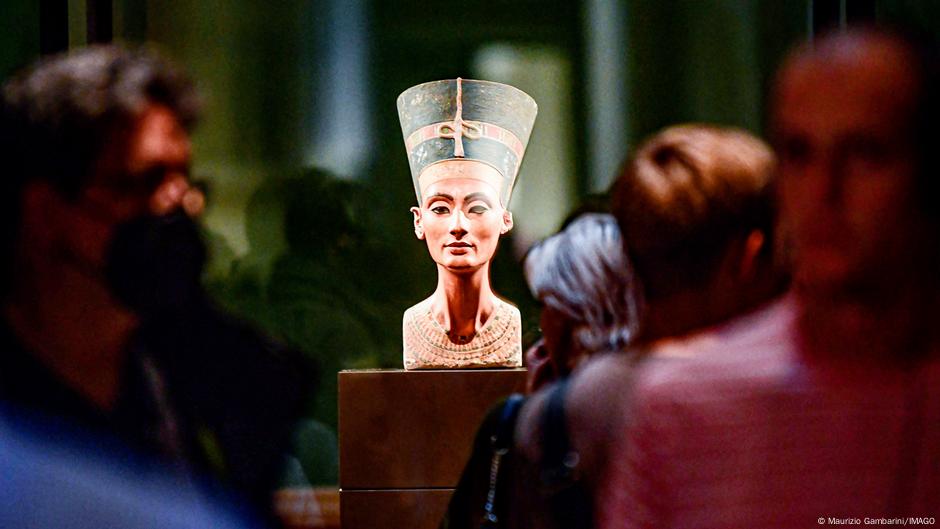Introduction to Queen Nefertiti
An enduring global symbol of beauty, power and mystery that captivated Hitler, Beyoncé and Arab Spring activists alike, Queen Nefertiti, whose name translates as “The Beautiful One Has Come,” is one of the most famous figures of antiquity. The great royal wife of Pharaoh Akhenaten, who radically changed Egyptian religion by promoting the worship of the sole sun god Aten, reigned more than 3,300 years ago. However, Nefertiti’s present-day fame is largely due to the discovery in 1912 of a painted, stucco-covered limestone bust by a team of German archaeologists led by Ludwig Borchardt.
The Discovery and Acquisition of the Bust
The bust was then brought to Berlin. Today it is “the undisputed star of the New Museum,” as it says on the website of the Prussian Cultural Foundation, which looks after the collection of the museum, which is part of the UNESCO-protected Berlin Museum Island. Claims for restitution began shortly after the bust was discovered. Now, with the opening of the Grand Egyptian Museum in Cairo, the calls are gaining momentum.
Calls for Restitution
Visitors on tours of the Grand Egyptian Museum are being asked to sign a petition initiated last year by former Egyptian Minister of Tourism and Antiquities Zahi Hawass. “Despite many ignored calls for meaningful dialogue and requests for recognition of how this unique artifact came to Germany, today’s petition aims to reignite that conversation, encourage the return of the bust to Cairo and elicit a dignified response from the German authorities,” says the petition, which calls on the German culture minister and the Prussian Cultural Heritage Foundation to address the matter.
The German Position
A spokesman for the German culture minister told DW in a written statement. The Foreign Office, meanwhile, states that it has “received no request from official Egyptian authorities to return the Nefertiti bust” and that it is “not known that such demands were ever made to the German government.” The Prussian Cultural Heritage Foundation did not respond to DW’s inquiries, but its stance on the issue has not changed in recent years.
A Legal Purchase?
“The bust of Nefertiti was found during an excavation approved by the Egyptian Antiquities Administration,” Stefan Müchler, spokesman for the Prussian Cultural Heritage Foundation, told DW in a written statement. “It came to Berlin due to a division of the find – which was common at the time – which included many other objects.” However, Egyptian researcher and heritage activist Monica Hanna disputes this claim. According to their research, Ludwig Borchardt intentionally and fraudulently downplayed the value of the bust when dividing up the finds.
The Ethical Validity of the Law
German historian Sebastian Conrad, author of "The Making of a Global Icon: Nefertiti’s Twentieth-Century Career," added that beyond the controversial details surrounding the division of the find, the ethical validity of the law itself should be questioned. "It is a law that could only exist under the unequal power relations of the imperialist era, because Egypt was essentially an English colony at the time. That means, in my opinion, that the real question is whether one can legitimately invoke such a law," he told DW.
Attempt at Restitution Blocked by Hitler
Egyptologist Monica Hanna also doubts Germany’s position that there is no claim for reimbursement from the Egyptian government. She points out that the Egyptian authorities requested its return shortly after the bust was first publicly exhibited in Berlin in 1924. In 1925, Egypt threatened to ban German excavations on its soil unless the bust was returned. James Simon, the philanthropist who financed Borchardt’s excavations and donated the famous Nefertiti bust to the Berlin State Museums, personally advocated for an exchange of pieces with Egypt and contributed to negotiations for Nefertiti’s return.
Survived World War II in a Plastic Bag
Germany has also argued that the bust was too fragile to be transported back to Egypt. The historian Sebastian Conrad admits that he is not an expert on this question, but simply points out that "at the end of the Second World War it was put in a plastic bag and stored in a salt mine in Thuringia. It was then transported to Wiesbaden. So it has already made several journeys, not just from Cairo to Berlin."
A Fundamental Question for Germany
Berlin is currently working on the return of colonial objects, particularly through the return of the Benin bronzes to Nigeria. Although it was the result of a long campaign by activists, making such a concession was comparatively easier as part of the Berlin collection of 512 objects could be returned to Nigeria while another could remain on display at the Humboldt Forum through a long-term loan. Nefertiti is of course a unique piece. Nevertheless, Conrad and Zimmerer believe that there are alternatives to sticking with the original: a reproduction of the bust, displayed with the history of the find and the restitution efforts “would certainly be convincing,” says Conrad.

